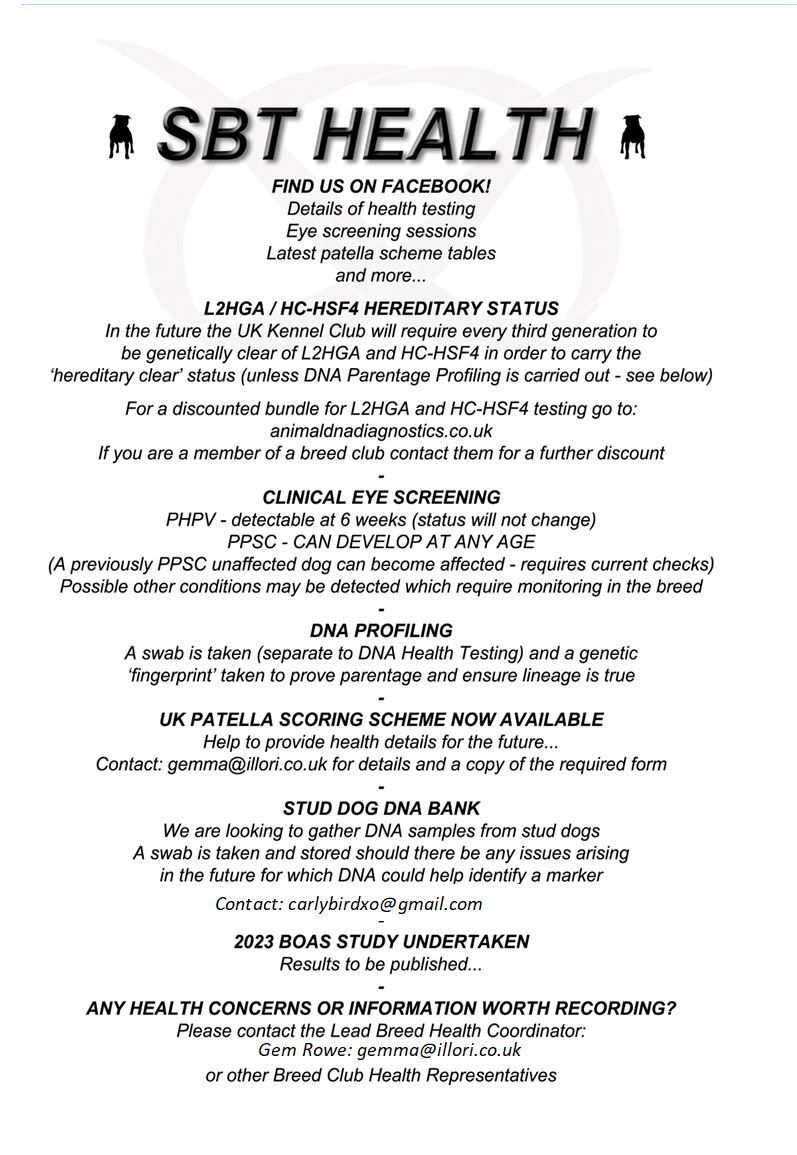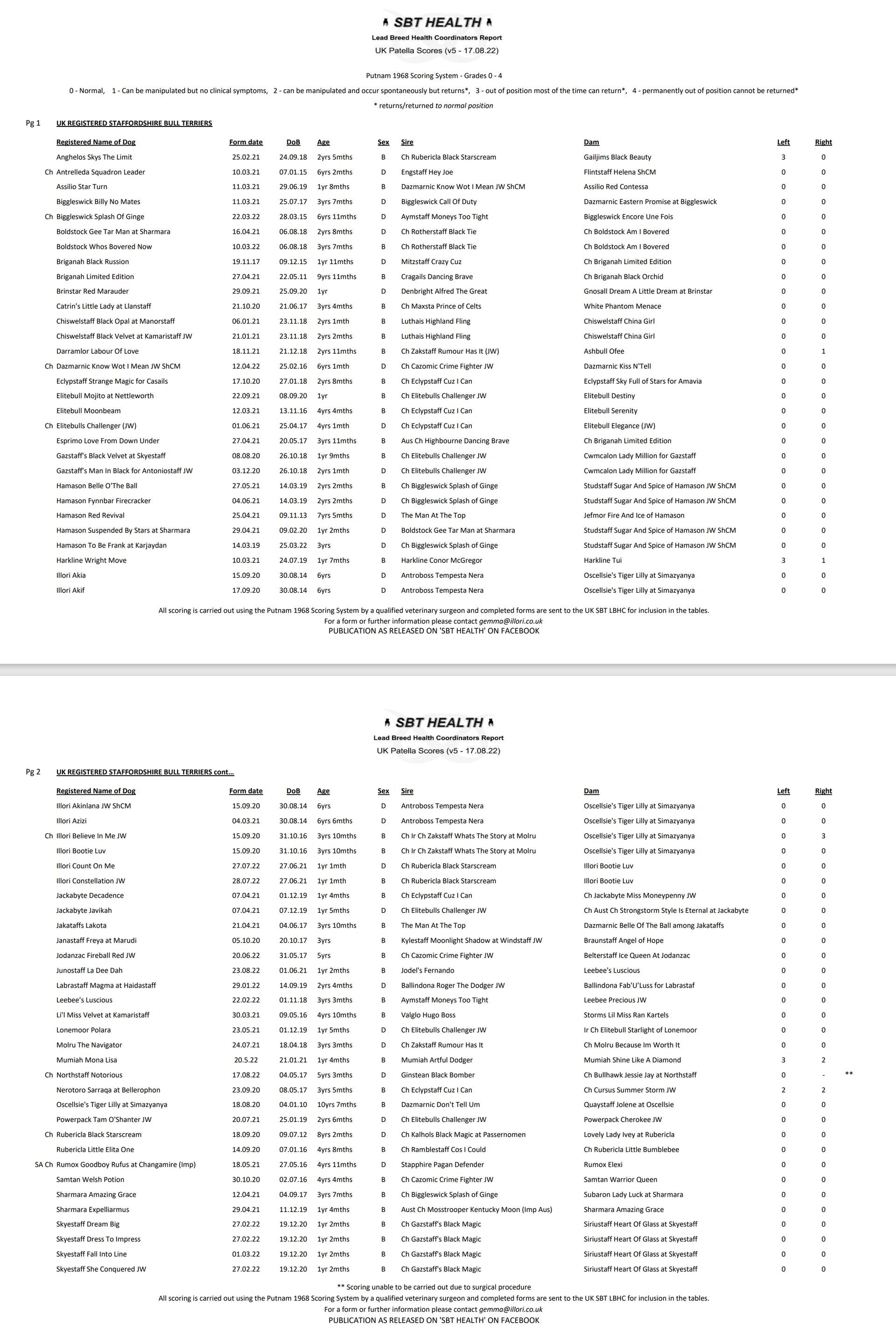Health

There will be an update 'Where are we now?' on November 14th for anyone interested

Health Co-ordinators
If you have any concerns about a particular health condition in your breed then you may wish to contact the SBT breed health co-ordinator. They are individuals working on behalf of breed clubs and councils who are advocates for the health and welfare of their chosen breed. They act as a spokesperson on matters of health and will collaborate with The Kennel Club on any health concerns the breed may have.
To contact your breed health co-ordinator please email
Gemma Rowe
You can find the SBT Health Facebook page here

Important Health Schemes and Tests
All responsible breeders should use the following schemes, tests and advice:
- Eye screening scheme (BVA/KC/ISDS) and only breed from clinically unaffected dogs
- DNA test - HC-HSF4 and only breed from DNA genetically CLEAR dogs
- DNA test - L-2HGA and only breed from DNA genetically CLEAR dogs
- Litter eye screening for PHPV (from 6 weeks - prior to leaving the breeder)
-
The Kennel Club are now recommending Elbow Scoring as evidence of Good Practice when breeding. As this has only recently been introduced it will take some time for breeders to include this in their breeding practice
These should be MINIMUM requirements for anyone breeding responsibly.
Breeders can also make use of the Puttnam patella scoring scheme, BVA hip and elbow scoring schemes. There is also DNA testing for coat colour, which although not a health issue, can determine whether you dog carries the genes to produce dilute (blue) or tan point ('black & tan') coat colouring
For more information about hip and elbow screening and scoring check out the British Veterinary Association website
For DNA health testing and profiling we recommend Canine Genetic Testing, based at Cambridge University and with all profit going directly to the Canine Gentics Centre
For details of upcoming clinical eye testing sessions check
here
or join this
Facebook group
If you are planning to buy a pup and the breeder is not adhering to the above advice they are not considering the future health and welfare of the Staffordshire Bull Terrier
L2-HGA
This video shows Newton, a Staffordshire Bull Terrier affected by the neurological disease L2-HGA. This should never have happened! Breeders should only ever breed from dogs and bitches that have known (and clear) DNA status for L2-HGA to ensure that NO dog has to suffer like Newton, and his owners, do. It is why it is IMPERATIVE that anyone buying a puppy insists that they see evidence of the DNA genetic and clinical health tests for the parents of pups born. The breed's future is in YOUR hands
For anyone that is buying a Kennel Club registered pup make sure you use the Health Test Results Finder to check the DNA (for L2-HGA and HC) and clinical status (for PHPV) for the sire and dam of the litter
Patella Scoring
IS PATELLAR LUXATION PAINFUL?
The commonest sign of patellar luxation is limping, which can be intermittent or constant. Limping is caused by abnormal joint mechanics, pain, or a combination of both. Many affected dogs skip for a few steps, then spontaneously return to normal. In these individuals, it’s likely (but not certain) that limping is caused by abnormal joint mechanics. How can we determine if limping is caused by pain? Signs of chronic pain include frequent or constant lameness and reduced exercise tolerance.
Scoring can be done by any competent vet and is not expensive (often just the cost of a veterinary consultation). The Puttman Scale is used to determine grade as below:
The four grades of developmental dislocation of the canine patella, also known as patellar luxation:
Grade I: The patella can be manually dislocated but returns to a normal position when released. Affected dogs aren't lame.
Grade II: The patella dislocates spontaneously when the knee is flexed or extended. Reduction is possible by extending the knee or applying lateral pressure to the patella. A torsional deformity of the tibia is typical. Some dogs with grade II patellar luxation are lame and some aren't.
Grade III: The patella is permanently dislocated but can be manually reduced. It spontaneously dislocates if lateral pressure is released. Severe bony deformities are typical.
Grade IV: The patella is permanently dislocated and cannot be reduced.
A form to record grading can be obtained from the SBT Lead Breed Health Coordinator
Results for patella scoring are published on a regular basis by the Lead Breed Health Coordinator

